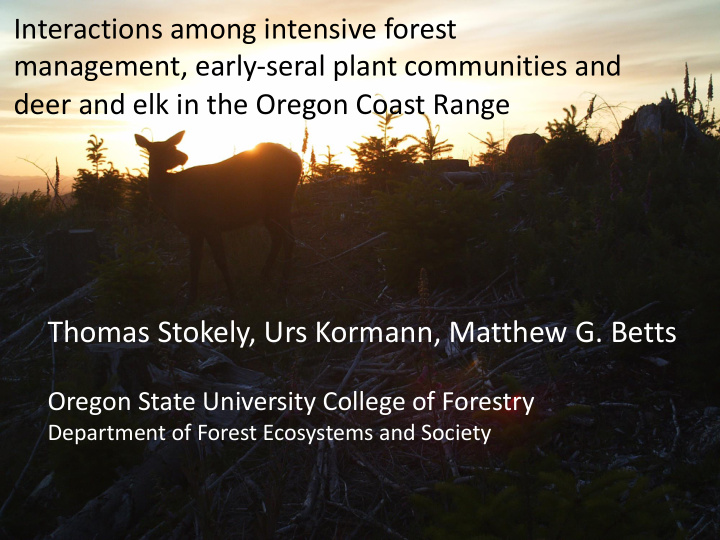



Interactions among intensive forest management, early‐seral plant communities and deer and elk in the Oregon Coast Range Thomas Stokely, Urs Kormann, Matthew G. Betts Oregon State University College of Forestry Department of Forest Ecosystems and Society
1) Interactive effects of herbivory and herbicide on plant communities 2) Ecosystem services of deer and elk in managed plantations 3) Effects of intensive forest management on stand use by deer and elk
Cervids: Hungry Hungry Herbivores Deer and elk are highly selective Selectivity is based on forage availability Strong effects on plant communities Plant competition and herbivory Mediated by disturbance and plant community characteristics
Disturbance and early-seral communities
Finding Forage in Managed Forests HERBICIDES
Hypotheses: Interactions between IFM, plant communities Hypotheses: and deer and elk 1) Herbivory should exacerbate the effects of IFM where forage has been diminished by herbicides 2) Deer and elk should provide an ecosystem service when forage is retained and a disservice where forage is diminished 3) Stand use should be reduced where forage has been diminished by herbicides
HERBICIDE TREATMENTS Planted Control ~1100 trees/ha Planted Broadleaf ~1100 trees/ha release spray Light Herbaceous spray Broadleaf spray Planted Big-leaf maple Site preparation ~1100 trees/ha where needed Moderate Herbaceous spray Broadleaf spray Planted Broadleaf Broadleaf Site preparation ~1100 trees/ha release spray release spray Intensive Herbaceous Herbaceous Herbaceous spray spray spray 2010 2011 2012 2013 2014
Methods: Experimental Design
Methods: Data Collection 1) Abundance of plant species – forage and non- forage species 2) Conifer Regeneration – Volume and Survival 3) Camera Trap Captures – detections per day
Plant Community: 2012
Plant Community: 2015
Native and non-native early-seral
X = Deer and elk excluded Natives vs. Non-natives O = Open to deer and elk CONTROL LIGHT MODERATE INTENSIVE
Forage
Deer and elk excluded Forage Cover Open to deer and elk Control Light Moderate Intensive Forage cover 11 12 13 14 15 15 11 12 13 14 11 12 13 14 15 11 12 13 14 15 Year Year Year Year
Deer and elk detections
Browsed Douglas-fir Proportion Browsed 2011 2012 2013 2014 2015 Year
Crop-tree Volume Deer and elk excluded Open to deer and elk Control Light Moderate Intensive Tree Volume (cm³) 12 13 14 15 11 12 13 14 15 12 13 14 15 11 11 12 13 14 15 11 Year Year
Plant Communities Light and Control: Highest forage production, most resistant to changes in community composition Moderate and Intensive: reduction in natives, increase in non-natives with herbivory Forage reduced by herbivory among all stands by 2015
Plantation Development Ecosystem service in Intensive stands Possible disservice in Light stands Competition and herbivores
Beyond the browse line _____
Cervid Stand Use Variability in elk herds, use of open stands & distance sampling Deer and brushy habitats Landscape-scale early-seral Other factors (e.g. hunting, predator populations)
1) Forage removed among all treatments – altered native/non-native composition with herbicides and herbivory 2) Ecosystem services of herbivory in Intensive, potential disservice in Light herbicide treatments – altered completion 3) Stand-use highly variable: forage, detection and landscape conditions important variables of interest
Acknowledgements IFM Primary Investigators J. Verschuyl, AJ Kroll, U. Kormann, S. Harris, D. Frey, J. Hatten, D. Maguire Cooperating forest managers and biologists M. Rochelle, J. Bakke, J. Johnson, S. Keniston, J. DeRoss, R. Frazzini, A. Heimgartner, T. McBride, J. Theimens, A. Weathers, M. Taylor, J. Travers, D. Irons, J. Light Cooperating companies and agencies Weyerhaeuser, Co., Hancock Forest Management, Oregon Department of Forestry Funders USDA Agriculture and Food Research Initiative, Oregon Forest Industries Council, OSU College of Forestry: Noble Foundation, Giustina Foundation, Fish and Wildlife in Managed Forests Program and Institute for Working Forest Landscapes Research technicians A. Kern, E. Ireland, S. Gilsdorf, E. McClelland, S. Alanko, S. Gilsdorf, D. Jones, A. Turner, J. Scott, J. Baldwin, J. Hannon, M. Vernon, T. Hruska, M. Hovland, T. Laird, D. Uzes, A. Comstock, P. Callahan, D. Meuse, C. Adlam, T. Schrautemeyer, B. Gholson, K. Soderland, J. Walrod, E. McDougal, M. Silbernagel, A. Randazzo, L. Sherman, J. Gibson, J. Miller, P. Bruce, K. Ray, Keiran Woolley, A. Gunsulus, E. Beuttenuller, C. Mathis
Questions or suggestions?
Recommend
More recommend